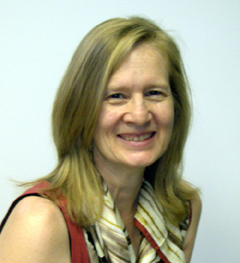Dr. Mary Anne Holmes
Professor of Practice, Geosciences
Clay Sedimentology/Women's and Gender Studies
Ph.D. 1988, Florida State University
214 Bessey Hall
Lincoln NE 68588-0340
voice: 402-472-5211
fax: 402-472-4917
email: mholmes2 <<at>> unl.edu
|
|
My research
is on clay minerals as products of hydrothermal and pedogenic weathering, burial
diagenesis, and as sedimentary particles bearing information on provenance and
paleoclimates. Clays are best as paleoclimatic indicators when found in place,
in paleosols, before being eroded and transported. Paleosols now in
the deep sea that were formed on subaerially erupted basalt flows provide a near-ideal condition for interpreting paleoclimate and
duration of landscape exposure prior to subsidence. I've studied cores from three Ocean
Drilling Program (ODP) legs: Leg 120 (southern Indian Ocean), Leg 144 (central
Pacific Ocean), and Leg 152 (North Atlantic Ocean), that have now-submerged paleosols
in varying states of development and preservation.
Clays might be used for
paleoclimate studies, but in our lab we find that when they have been eroded
and transported, they are better provenance indicators. Minor changes in clay
content and composition helped us unravel what earthly sedimentologic process
varied as Milankovich cycles drove variations in Paleocene sediment type on
the Blake Nose, east coast of Florida (ODP Leg 171B). Provenenance signals
from clay indicated the shift of sediment being shed from Iceland to sediment
being shed from Greenland in the North Atlantic (ODP Leg 152).
Clays can reveal key details
of weathering and diagenesis. My research on aged ocean basalt from ODP Leg
102 used clays to decipher the weathering of a mid-ocean ridge by seawater
as it passed off-axis. Those weathering processes mimic those in a waterlogged
soil. In a different vein, clay altered by high heat flow from the Ivory/Ghana
coast of Africa (Leg 159) allowed dating of the opening of the South Atlantic
Ocean along the Romanche Fracture Zone.
I have an
appointment in the Women's
and Gender Studies Program at UNL and am currently doing research on strategies to overcome barriers
to the advancement of geoscience women in academia. This interest grew out
of my serving as President of the Association
for Women Geoscientists in 2000-01. I was named a Fellow of the Association for Women in Science (AWIS) in 2008.
I teach
senior/graduate-level courses on Clay Mineralogy and on Sedimentary Core Description,
and first-year courses on Physical
Geology and Oceanography.
We have an active outreach program, working with local teachers and youth-serving organizations. Outreach provides our students (graduate and undergraduate) great opportunities to explain science to the public. We co-sponsor Dinosaurs & Disasters Day with the University of Nebraska State Museum in February. In 2008, attendance reached a record 2,080 paying attendees for a day of fun, hands-on activities that engaged and educated.
Joint Oceanographic
Institutes/U.S. Science Advisory Committee (JOI/USSAC) Distinguished Lecturer,
1995-96. Lecture Title: "Paleosols From the Deep Sea: ODP's Dirty Little
Secret".
Go to:
PUBLICATIONS
FUNDING
RESEARCH
OUTREACH
